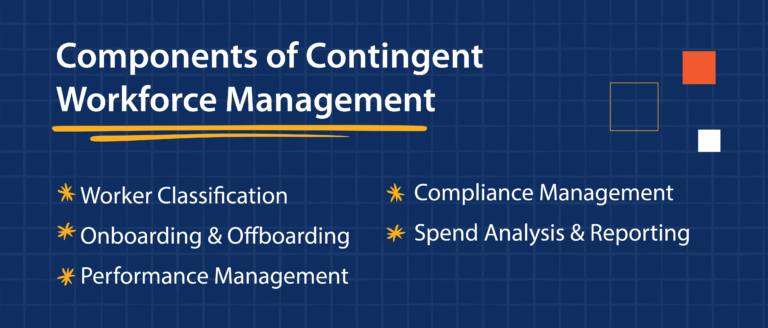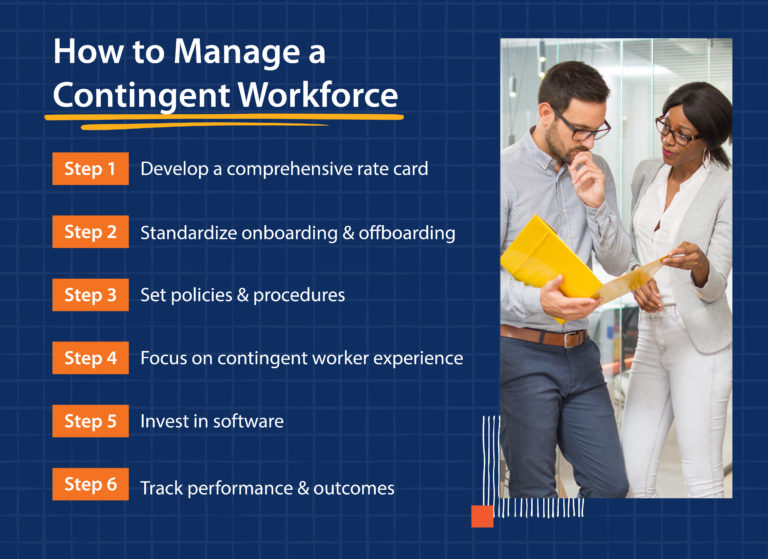The modern workforce is built of a variety of worker types, including full-time employees, part-timers, and contingent workers. As the contingent workforce — made up of freelancers, contractors, consultants, and temporary employees — continues to grow, HR leaders must adopt new strategies to manage this evolving segment effectively. Contingent workforce management (CWM) offers a structured approach to overseeing non-traditional workers, which helps organizations maintain flexibility while meeting performance, compliance, and cost goals.
What is Contingent Workforce Management (CWM)?
Contingent workforce management refers to the processes organizations use to manage and optimize its non-employee workers, including independent contractors, freelancers, temporary staff, and consultants. This management approach involves overseeing procurement, onboarding, compliance, performance, and payment processes to ensure contingent labor supports business goals effectively.
Importance of Contingent Workforce Management
Contingent labor management is important for a number of reasons, especially becuase it:
- Ensures regulatory compliance, so employers avoid penalties for misclassifying contingent workers.
- Helps control spending on external talent, providing visibility into labor costs and identifying opportunities for savings.
- Oversees contingent worker access to systems, data, and facilities to reduce security and intellectual property risks.
- Integrates contingent workers into overall talent strategies, which allows companies to optimize their total workforce composition.
Components of Contingent Workforce Management

Effective contingent worker management has several interconnected components:
- Worker classification: Procedures to correctly categorize workers as employees or independent contractors according to legal definitions.
- Onboarding and offboarding: Processes for efficiently bringing contingent workers into the organization and ending the relationship.
- Performance management: Systems to track, measure, and evaluate contingent worker contributions.
- Compliance management: Mechanisms to ensure adherence to labor laws, tax regulations, and industry-specific requirements.
- Spend analysis and reporting: Tools to monitor contingent labor costs and provide insights for decision-making.Benefits of Effective Contingent Workforce Management.
Benefits of Effective Workforce Management
Benefits of using effective CWM include:
Cost Control and Visibility
With CWM, organizations gain complete visibility into contingent workforce spending, which helps standardize rates, consolidate vendors, and identify cost-saving opportunities. The additional transparency allows businesses to make data-driven decisions about their contingent labor investments and stay within budget.
Enhanced Compliance and Risk Mitigation
Proper contingent workforce management significantly reduces legal and regulatory risks by ensuring proper worker classification, contract management, and compliance with labor laws across different jurisdictions. As a result, organizations can avoid costly penalties, lawsuits, and damage to their reputation.
Access to High-Quality Talent
Strategic CWM also helps organizations build talent pools of pre-vetted, high-performing contingent workers who can be engaged quickly when needs arise. This approach shortens time-to-productivity and ensures access to specialized skills that may not exist within the permanent workforce.
Improved Operational Efficiency
By standardizing and automating processes related to onboarding, time tracking, and payment of contingent workers, CWM eliminates administrative burden and reduces cycle times. HR and procurement teams can then focus on more strategic activities rather than manual processes.
Better Strategic Workforce Planning
With comprehensive data on contingent worker utilization, performance, and costs, organizations can make informed decisions about optimal workforce composition. This strategic insight helps determine when to hire full-time employees versus engaging contingent talent.
Challenges of Contingent Workforce Management
Workforce management, especially when it involves contractors working on their own schedules and from various locations, can be a challenging endeavor. Common challenges include:
- Many companies lack complete visibility into their contingent workforce, with hiring happening across departments and no centralized tracking.
- With a variety of vendors, consultants, and freelancers, it can be hard to achieve consistency and ensure work quality.
- Determining proper classification between employees and independent contractors remains complex, with significant legal and financial consequences for errors.
- Ensuring contingent workers feel connected to the organization while maintaining appropriate boundaries presents ongoing challenges.
- Managing access to systems and protecting proprietary information requires careful governance.
Contingent Labor Management Strategies
There are different strategies and approaches for effective contingent workforce management.
You could centralize all contingent workforce management to a specific team or department. Or you could use a decentralized system, where each department manages their own contingent labor. You could also use a combination of the two, too!
For example, all timesheet approvals and payments could be centralized, while project management remains with separate departments.
If you hire contingent workers through a staffing agency, the agency often handles their payroll and scheduling. You could also seek out the services of a managed service provider to oversee your contingent workforce.
How to Manage a Contingent Workforce

Follow these best practices to craft an effective contingent workforce management strategy.
- Develop a comprehensive rate card: Establish market-based rate guidelines for different skill categories to ensure cost consistency.
- Standardize onboarding and offboarding: Ensure every contingent worker follows a consistent process, including compliance documentation and clear role expectations.
- Set policies and procedures: Set formal guidelines for how managers engage with contingent labor to reduce confusion and risk. For example, managers can’t dictate when freelancers work.
- Focus on contingent worker experience: Design communication and engagement practices that integrate contingent workers appropriately while maintaining legal boundaries.
- Invest in software: Automate workforce management tasks with workforce management software.
- Track performance and outcomes: Use key performance indicators (KPIs) to evaluate contingent workers, helping ensure quality work and making future talent decisions easier.
Assessing Contingent Workforce Management Needs
To determine whether your organization needs a CWM solution, ask:
- Do we lack visibility into our contingent workforce?
- Are compliance and misclassification risks increasing?
- Is our contingent labor spend difficult to track or manage?
- Are we missing opportunities to optimize performance?
If you answer yes to any of these, it’s time to explore a streamlined CWM solution that can manage the entire contingent worker lifecycle while ensuring compliance and cost control. That solution is Paycor.
How Paycor Helps with Contingent Workforce Management
Whether you’re managing full-time employees, contractors, or a mix, Paycor offers the tools you need to modernize people management. The unified platform streamlines every aspect of workforce management, from recruitment and onboarding to scheduling, time tracking, and payroll.
Want to learn why 30,000+ companies trust Paycor with their contingent workforce management needs? Check out our workforce management solutions.









